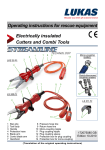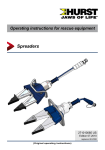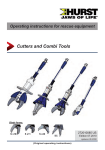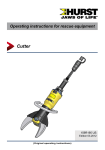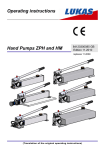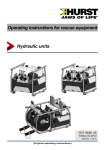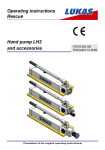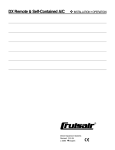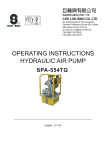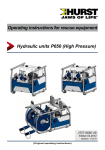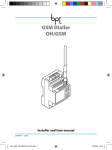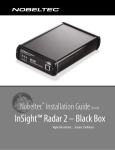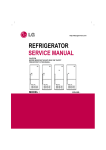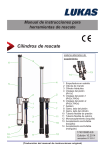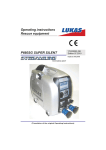Download User Manual - Hurst Jaws Of Life
Transcript
Operating instructions for rescue equipment 274010085 US Issue 06.2008 Rescue Rams replaces 09.2007 6 8 alternative coupling system: 4 5 14 2 1 7 3 3 11 9 10 12 9 13 2 1 1 2 3 4 7 5 6 7 11 8 9 10 10 11 12 13 12 14 Star grip Control valve Hydraulic cylinder Piston rod (R41x) Piston rod 1 (R42x; R43x) Piston rod 2 (R42x; R43x) Handhold Claw, piston side Claw, cylinder side Hose, pressure Hose, return Mono-coupling male Quick-disconnect coupling (male) Quick-disconnect coupling (female) Content Page 1. Hazard classes 4 2. Product safety 5 3. Safety regulations for hydraulic hoses 8 3.1 Advices for hoses 9 3.2 Safeguarding the environment in the event of failure of the hoses 9 3.3 Storage of hoses 9 3.4 Labelling the hoses 10 3.5 Dates for inspections and replacement of hoses 10 3.6 Examples of possible defects of hoses 10 4. Proper use 5. Description of the functions 11 12 5.1 Description 12 5.2 Circuit diagram 12 5.3 Control of the operating movements 12 5.4 Type R 41x 13 5.5 Type R 43x / R 42x 13 5.6 Hydraulic supply 13 5.7 Hoses 13 6. Connecting the equipment 14 6.1 General information 14 6.2 Coupling the mono-couplings 14 6.3 Coupling the quick-disconnect couplings (alternative system) 15 7. Operation 16 7.1 Preparatory measures 16 7.2 Danger notes 18 7.3 Operating the star grip (cover: item 1) 19 7.4 Use of extensions 19 8. Dismantling the equipment / deactivation following operation 19 8.1 Rescue ram 19 8.2 Hydraulic unit 20 8.3 Hoses 20 9. Maintenance and service 20 2 10. Repairs 21 10.1 General information 21 10.2 Preventative service 22 10.3 Repairs 23 11. Troubleshooting 26 12. Technical Data 29 33 12.1 Recommended hydraulic fluid 12.2 Hoses 33 12.3 Operating and storage temperature ranges 33 13. Notes 34 3 1. Hazard classes We distinguish between various categories of safety notes. The table below gives you an overview of the assignment of symbols (pictograms) and key words to the specific hazard and possible consequences. Damage / injury to device human Pictogram Key word Definition Consequences DANGER! Immediate danger Death or major injury WARNING! Potentially dangerous situation Potential death or major injury CAUTION! Less dangerous situation Minor or slight injury CAUTION! Danger of damage to device / environment Damage to the equipment, damage to the environment, damage to surrounding materials REMARK Advice for application and other important / useful information and advice No injury / damage to persons / environment / equipment - Wear helmet with face protection Wear safety gloves Wear safety shoes Proper recycling Observe principles of environmental protection Read and observe operating instructions 4 2. Product safety HURST products are developed and manufactured in order to guarantee the best performance and quality when used properly. Operator safety is the most important aspect of the product design. Moreover, the operating instructions are intended to help the safe use of HURST products. The generally applicable, legal and other binding regulations pertaining to the prevention of accidents and protection of the environment apply and are to be implemented in addition to the operating instructions. The equipment may only be operated by persons with appropriate training in the safety aspects of such equipment – otherwise, there is a danger of injury occurring. We would like to point out to all users that they should read carefully the operating instructions and the instructions contained therein before they use the equipment, and that they should carefully follow such. We further recommend that a qualified trainer train you in the use of the product. WARNING / CAUTION! The operating instructions for the hoses, the accessories and the connected hydraulic equipment must also be observed! Even if you have already received instructions on how to use the equipment, you should still read the following safety notes through again. WARNING / CAUTION! Ensure that the accessories and connected equipment used are suitable for the max. operating pressure! Please ensure that no body parts or clothing get stuck between the visibly moving parts (e.g. piston claw and cylinder). It is prohibited to work under load if this load is lifted exclusively by hydraulic equipment. If this work is absolutely imperative, additional mechanical supports must be used. Wear protective clothing, safety helmet with visor, protective gloves Inspect the equipment before and after use for visible defects or damage The responsible department is to be informed immediately of any changes (including to the operating behaviour)! If necessary, the equipment is to be deactivated immediately and secured! Inspect all cables, hoses and screwed connections for leaks and externally visible damage! If necessary, repair immediately! Squirting oil can result in injuries and fires. In the event of malfunctions, immediately deactivate the equipment and secure it. The malfunction is to be repaired immediately. Do not carry out any changes (additions or conversions) to the equipment without obtaining the prior approval of HURST. 5 Observe all safety and danger notes on the equipment and in the operating instructions. All safety and danger notes on the equipment are to be kept complete in a legible condition. Any mode of operation which impairs safety and/or stability of the equipment is forbidden! Comply with all specified dates or dates specified in the operating instructions pertaining to regular controls / inspections on the equipment. Safety devices may never be deactivated! The maximum permitted operating pressure noted on the equipment must not be exceeded. Before the equipment is switched on/started up, and during its operation, it must be ensured that nobody is endangered by the operation of the equipment. Only original HURST accessories and spare parts may be used for repairs. When working close to live components and cables, suitable measures must be taken to avoid current transfers or high-voltage transfers to the equipment. Please note that, when applying pressure, tearing or breaking can cause falling material, or sudden removal of such can cause it to suddenly catapult off: necessary precautions need to be taken. Only touch any broken-off parts wearing protective gloves, since the torn edges can be very sharp. Please ensure that, when working with this equipment or during transportation of such, you don’t get stuck in the looped hoses and trip. The build-up of static charge with the potential consequence of spark formation is to be avoided when handling the equipment. The equipment is filled with a hydraulic fluid. These hydraulic fluids can be dangerous to health if swallowed or their vapours inhaled. Direct contact with the skin is to be avoided for the same reason. Please also note that hydraulic liquids can also have a negative effect on biological systems. 6 When working with or storing the equipment, ensure that the function and the safety of the equipment are not impaired by the effects of stark external temperatures or that the equipment is damaged in any way. Please note that the equipment can also heat up over a long period of use. Ensure adequate lighting when you are working. Before transporting the equipment, always ensure that the accessories are positioned such that they cannot cause an accident. Always keep these operating instructions within reach where the equipment is used. Ensure the proper disposal of all removed parts, left-over hydraulic fluid, left-over oil and packaging materials! The generally applicable, legal and other binding national and international regulations pertaining to the prevention of accidents and protection of the environment apply and are to be implemented in addition to the operating instructions. W A R N I N G / C A U T I O N ! The equipment is to be used exclusively for the purpose stated in the operating instructions (see chapter “Proper Use”). Any other or further use is not considered proper use. The manufacturer / supplier is not liable for any damages resulting from improper use. The user bears sole responsibility for such. Observance of the operating instructions and compliance with the inspection and maintenance conditions are part of the proper use. Never work when you are overtired or intoxicated! 7 3. Safety regulations for hydraulic hoses C A U T I O N ! - Never bring the hoses into contact with brake fluid. - The hoses are to be cleaned immediately should they come into contact with the following fluids: • acids, lyes, solvents • alcohol, fuel and ATF (Automatic Transmission Fluid) • battery acid • phosphate ester It is also imperative that the hoses be inspected for damage following cleaning! If necessary, the hose assemblies are to be replaced! 1 2 3 4 6 5 Fig. 2 8 3.1 Advices for hoses - - - - - - The determined operating pressure may not be exceeded. Tensile load and torsion to the hoses must be avoided (see figure 2, item 1). 1). Do not kink the hoses (see figure 2, item 2). 2). Do not drag or lay hoses across sharp edges (see figure 2, item 3). 3). Do not connect twisted hoses (see figure 2, item 4). 4). Never drive over the hoses with a motorised vehicle. Hoses laid loosely across roads or paths are to be protected from damage e.g. by hose protection ramps (see figure 2, item 5). - In the event of high external temperatures, the hoses are to be installed either at an adequate distance from the heat-radiating components or are to be protected by suitable measures (see figure 2, item 6). - Do not hang any weights on the hoses. 3.2 Safeguarding the environment in the event of failure of the hoses Hoses must be laid or secured such that, in the event of a failure of the hose, danger is avoided as far as possible. Danger can be caused by: - The hose thrashing about following a tear caused by external influences, for example. - The pressure media leaking under pressure, - The lighting of leaking pressure media within the vicinity of an ignition source. The danger can be avoided by means of protective coverings or screening, for example. WARNING / CAUTION for hairline cracks! - Leaking hydraulic fluid under high-pressure can cause serious injuries to the skin. - In the event of injuries, immediately consult a doctor! Hydraulic fluid must immediately be removed from wounds! - Do not use your fingers to detect leaks! - Relieve the hydraulic system before you loosen connections! 3.3 Storage of hoses - Even when stored correctly and used properly, hoses are subject to a natural ageing process. This means that their period of storage and period of use are restricted. The following is to be observed when storing the hoses: - Store in a cool, dry and low-dust condition (possibly wrap in plastic film). Avoid direct sunlight and UV rays. Screen from heat sources in the vicinity. - Do not use any ozone-forming lighting fixtures such as fluorescent light sources, mercury vapour lamps) or electrical equipment close to the equipment. - Store hoses such that they are stress-free in a flat position. If storing in rings, the smallest bending radius stated by the manufacturer may not be exceeded. 9 3.4 Labelling the hoses - The hose is to bear the name of the manufacturer and the authorised operating pressure. - The press sleeve is to bear the maximum authorised operating pressure and the manufacturers identification and month / year of manufacture. month / year operating pressure manufacturers identification 3.5 Dates for inspections and replacement of hoses - After each use, inspect the hoses for external damage, tears, kinks and swollen points! - The operator is responsible for ensuring that the hoses are replaced at regular intervals, even if there are no visible safety defects on the hoses. - The hoses must be replaced 10 years after its manufacture (see labelling) at the latest! - Hoses are to be inspected by an expert to ensure that they are safe before they are used for the first time and then at least once per year. Please see the following for possible defects. An expert is somebody who, due to his professional education and experience, has sufficient knowledge in the field of hydraulic hoses and who is familiar with the relevant national health and safety regulations at work, guidelines and generally acknowledged technical regulations (e.g. EN standards) such that he can assess the safe condition of the hydraulic hoses.. 3.6 Examples of possible defects of hoses - Damage to the external layer through to the inside (e.g. abrasive spots, cuts or tears). - Embrittlement of the external layer (formation of cracks on the hose material). - Distortions not in line with the natural form of the hoses, in pressure-free or in pressurised condition or bend, e.g. separation of the layers, blistering, squashed parts, kinks. - Leaks. - Installation requirements have not been complied with. - Shifting of the hose from its fitting. - Damage or deformations to the fitting which impair the function and stability of the fitting or the connection between the hose and the fitting. - Corrosion to the fitting or metal insert which impairs the function and stability. - Periods of storage and use have been exceeded. 10 4. Proper use The HURST rescue equipment is designed specifically for the emergency services. Their objective is to free people trapped in traffic accidents when the clearance distance of a spreader is insufficient e.g. by spreading or lifting car parts (see figure below). Their objective in other disasters is to rescue buried or trapped persons (e.g. to remove pieces of concrete from collapsed houses). The equipment can also be used under water at a depth of up to 40m (131 ft). CAUTION! In this case, you must strictly observe any leaks in order to avoid threats to the environment. Basically, objects can be pushed away or their position can be altered. WARNING / CAUTION! All objects which have to be moved are to be secured using stable supports or substructures. Furthermore, it must be ensured that the rescue ram cannot slip. We recommend that you use support bearings. These are available in the HURST accessories programme. WARNING / CAUTION! The following may not be squeezed: - live cables - hardened parts such as steering columns and rollers - explosive bodies such as airbag cartouches NEVER operate the rescue equipment at a higher operating pressure than that stated in the chapter “Technical data”. A higher setting can result in material damage and/or injuries. Spare parts and accessories for the rescue tool can be ordered from your authorisied HURST-dealer! 11 5. Description of the functions 5.1 Description The rescue rams are double-acting hydraulic cylinders. Extension / retraction are carried out hydraulically. The direction of travel is controlled via a valve with star grip. All rescue rams ensure full load-holding function when disconnected from the hydraulic supply (e. g. when being unintentional decoupled; defective hose, and so on). (For reasons of safety, rams R414 are internally safeguarded from 63 MPa = 630bar. When the safeguarding valve responds a screeching noise can occur. Even if the screeching noise occurs in unloaded condition, deactivate the equipment immediately and contact your authorized dealer or HURST directly!) 5.2 Circuit diagram To enable comprehension of the function, a simplified circuit diagram (hydraulic cylinder of the rescue equipment (A) + hand valve (B) ) are depicted here. Extend piston A Retract piston B 5.3 Control of the operating movements The piston movement is controlled via the star grip of the mounted valve. (see cover, item 1 and, below, figure 3). fig. 3 star grip 12 5.4 Type R 41x Type R 41x rescue rams are one-stage cylinders for applying pressure with a constant pressure force along the entire stroke. 5.5 Type R 43x / R 42x Type R 43x / R 42x rescue rams are multi-stage cylinders for applying pressure. Depending on the piston stage, they have varying pressure forces. However, the pressure force remains constant within one piston stage. An advantage offered by this range is the large stroke at a relatively low construction height. 5.6 Hydraulic supply A HURST motor pump or hand pump only may be used to drive the equipment. If the pump unit is a different make, you must make sure that it complies with HURST specifications, otherwise potential dangers may occur which are not the responsibility of HURST. Ensure in particular that the authorised operating pressure is not exceeded. REMARK: Before you use pumps from a different manufacturer, you must contact HURST or an authorised dealer. 5.7 Hoses The pump unit and the rescue ram are connected by hoses. 13 6. Connecting the equipment 6.1 General information There are two short hoses on the side of the equipment: they are connected to the pump unit via two hoses. All hose assemblies are marked with a colour and have couplings to enable unmistakable connection. REMARK: The devices can be equipped with different coupling systems. They differ only by the article number and not by the designation. Of course the coupling systems can also be reequipped at a later time. WARNING / CAUTION! Before connecting the equipment you have to pay attention that all used components are suitable to the max operation pressure of the pump unit! In the case of doubt you have to inquire HURST directly! 6.2 Coupling the mono-couplings The equipment is connected to the hydraulic pump via mono-coupling halves (male and female). dust protection caps mono-coupling halve (male) mono-coupling halve (female) Before coupling, remove dust protection caps, then connect male and female, and turn the locking sleeve of the female to direction „1“ until the locking sleeve locks into place. The connection is now in place and secure. Decoupling is by turning the locking sleeve to direction „0“. The equipment can also be coupled under pressure provided the connected equipment is not activated. 14 REMARK: We recommend coupling the coupling halves in a pressureless state, when working in areas with low ambient temperature and the usage of extension hose assemblies / hose reels, otherwise decoupling could need very high expenditure of force. To protect them from dust, the accompanying dust protection caps must be put back on. WARNING/CAUTION! The mono-couplings may not be screwed off the hose assemblies and / or the hose assemblies be confused! 6.3 Coupling the quick-disconnect couplings (alternative system) The equipment is connected to the hydraulic pump via quick-disconnect-coupling halves (male and female). X Y Before coupling unlock the connect socket by turning the sleeve into position X. Retract sleeve and connect plug and socket. Release sleeve and turn it into position Y. Now the connection has been made and locked. Uncoupling is done in the reverse order. CAUTION! Always connect the return line first and afterwards the supply line! REMARK: Coupling of the devices is only possible, when the hoses are depressurized. To protect them from dust, the accompanying dust protection caps must be put back on. WARNING/CAUTION! The quick-disconnect-couplings partly have special functions. Therefore it is not allowed to screw them off from the hoses or to exchange them! 15 7. Operation 7.1 Preparatory measures 7.1.1Commissioning Before commissioning and following repairs, the equipment must be deaerated. - Connect the equipment to the hydraulic pump (see chapter “Connecting the equipment”). - Extend / retract the equipment without any load at least twice (see chapter “Operation of the star grip”). REMARK: We recommend that during the deaeration, the attached aggregate for the hydraulic supply should stand on a higher level than the body of the rescue tool. Recommended procedure for the deaeration of the rescue tool: 1.) open and close fully with the piston rod facing upwards. 2.) open and close fully with the piston rod facing downwards. 3.) open and close fully with the piston rod facing upwards. 4.) open and close fully with the piston rod facing downwards. 7.1.2Inspection of the pump unit See separate operating instructions for the relevant pump unit (or for the hand pump). REMARK: Before each start-up of the hydraulic unit you have to make sure that the actuating valves are set to depressurized circulation. REMARK: Before coupling the quick-disconnect couplings, the actuating valves of the hydraulic unit are set to depressurized circulation. If you use mono-couplings, you can also couple when the hoses are pressurized! 16 7.1.2Support Before you can work using the rescue ram, you must ensure adequate support: this includes a necessary substructure. The rescue rams come equipped with a claw on the cylinder side and on the piston side so that they can become hooked (see figure 4). If this support is inadequate, such as in the case of a pushed-away front of car (see figure 5) or when lifting a vehicle (see figure 6), additional support bearings, cylinder attachments and, if necessary, protection using a belt, for example, are also necessary. Appropriate support bearings and practical cylinder attachments are available from the HURST accessories programme. fig. 4: fig. 5: fig. 6: 17 WARNING / CAUTION! Never use a rescue ram without claw or adequate accessories! The cylinder could slip away while moving and this could result ininjuries of the user. Furthermore the piston rod or the adapter of the claw could be damage thereby. WARNING / CAUTION! When positioning the rescue ram (without HURST support bearings), it is imperative that all four ends of both the piston claw and the cylinder claw are flush. When positioning the rescue ram (to a HURST support bearing), it is imperative that the area between the four ends of the claw are flush with the round bar of the bearing. This avoids a one-sided application of force into the cylinder. Lifted objects must then be secured by means of stable supports or substructures! 7.2 Danger notes Before activating the rescue ram, always ensure that there is no danger to persons either involved / uninvolved in the action by the movement of the piston rod or by flying fragments. Further avoid unnecessary damage to property belonging to others, objects not involved by the cylinder pistons / flying fragments. Holding the piston rod during operation of the equipment is strictly forbidden! 18 7.3 Operating the star grip (cover: item 1) Extend piston ( ): Turn the star grip in a clockwise direction (in the direction of the relevant symbol) and keep in this position. Retract piston ( ): Turn the star grip in an counterclockwise direction (in the direction of the relevant symbol) and keep in this position. “Dead-man” function: Following release, the star grip automatically returns to the central position, guaranteeing the full load-holding. 7.4 Use of extensions The R410 rescue ram may only be operated with the HURST extension (length = 250mm). No other rescue ram may be operated with an extension: furthermore, operation is only permitted using the original HURST extension. The extension is assembled from the righthand side as depicted. Extension Rescue Ram WARNING / CAUTION! Rescue rams with extensions are to be carefully monitored during their use. If there are signs of a serious change to its behaviour, work is to be interrupted immediately and, if necessary, even stopped altogether. After every use / interruption to use, carefully control the cylinder and the extension for damage! 8. Dismantling the equipment / deactivation following operation 8.1 Rescue ram Once work has been completed, the rescue rams are to be retracted so that just a few mm*) protrude. This relieves the hydraulic and mechanical strain on the equipment. REMARK: Due to fluctuations to the ambient temperature, the storage of rescue rams can cause small lifting motions in the equipment. This effect is a physical reaction to the expansion of the hydraulic fluid enclosed in the piston and rod side. For this reason, the storage room for rescue rams is to be designed such that there is up to 30mm (1.18 in.) space to allow for a potential extension to the length. *) 1 mm = 0.04 in. 19 8.2 Hydraulic unit Upon completion of work, the unit must be deactivated. 8.3 Hoses First of all, decouple the pressure hose then the return hose as described in chapter “Connecting the equipment”. Ensure that you put the dust protection caps back on to the couplings. 9. Maintenance and service The equipment is subject to very high mechanical stresses. A visual inspection is to be carried out after every use: however, at least one visual inspection is to be carried out annually. These inspections enable the early detection of wear and tear, which means that punctual replacement of this wearing parts prevents breakages from occurring. A function test is also to be carried out every three years or should there be any doubt regarding the safety or reliability of the equipment. (Please also observe the relevant valid national and international regulations pertaining to service intervals of rescue equipment). CAUTION! Clean off any dirt before controlling the equipment! WARNING / CAUTION! In order to carry out maintenance and repair works, tools appropriate for the job and personal protecting equipment are essential. Inspections to be carried out: Visual inspection Rescue ram • Cylinder and piston rod are to be free of damage and deformation, • Correct, firm fit of the claws, • Condition of the claws (chipped spots), • General tightness (leaks), • Operability of the star grip, • Existence and stability of handhold, • Labels completely existent and legibly, • Couplings must be easy to couple, • Dust protection caps must be available. Hoses • Visual control for visible damage, • Control for leaks. Function test • That the piston stroke can be extracted / retracted to its full length (see chapter “Technical data”) • Flawless extension / retraction upon activation of the star grip. • no further movement of the piston upon interruption of the valve activation during the process (“dead-man’s” function) 20 10.1 General information 10. Repairs Servicing may only be carried out by the manufacturer or personnel trained by the manufacturer and by authorised HURST dealers. Only HURST spare parts may be used to replace all components (see spare parts list) since special tools, assembly advice, safety aspects, inspections might have to complied with (see also chapter “Maintenance and Service”). During assembly, ensure the complete cleanliness of all components, since dirt can damage the rescue equipment! WARNING / CAUTION! Protective clothes must be worn when repairs are being carried out, since parts of the units can also be pressurised in an idle state. REMARK: Please always return the guarantee registration card to HALE PRODUCTS, INC. Only then are you entitled to the extended guarantee. REMARK: Before you use couplings from a different company, you must contact HURST or an authorised dealer. REMARK when using the quick-disconnect-coupling system: Overpressure protection of the rescue equipment (model with yellow coupling nipple on the return hose) If the equipment’s short hoses are not connected to a hydraulic unit, temperature increases can inadvertently cause pressure to build up in the equipment. Hence, the return hose of the equipment is equipped with a safety coupling (quickdisconnect coupling male, yellow). Unwanted overpressure (approx. 1.5 Mpa) is automatically released via this nipple: hydraulic fluid leaks. Should an hydraulic fluid leak on the coupling male be more frequent, please contact your dealer or HURST itself. If couplings from a different company are used which do not have this function, the overpressure protection can react in the valve of the rescue equipment. Hydraulic fluid leaks in the area of the star grip. Following the reduction in pressure, the valve is once again tight. Should the valve leak permanently, please immediately contact your dealer or HURST itself. CAUTION! Because HURST rescue equipments are appropriate for highest achievements, only components may be exchanged, which are specified in the spare parts list of the appropriate equipment.ipment may only be exchanged, when: - you have participated on a appropriate HURST service training. - you have the explicit permission of the HURST Service department (After inquiry, examination for the distribution of permission. Examination in each individual case necessary!) 21 10.2 Preventative service 10.2.1 Care regulations The exterior of the equipment is to be cleaned from time to time in order to protect it from external corrosion. Oil is to be applied to the metallic surfaces. 10.2.2 Function and load test If there is any doubt regarding the safety or reliability of the equipment, a function and load test must also be performed. HURST offers appropriate test equipment to this end. 10.2.3 Changing the hydraulic fluid - The hydraulic fluid must be changed after the equipment has been used approx. 200 times / after three years at the latest. - It must always be changed whenever the hydraulic fluid for the accompanying pump (motor / hand pump) is changed. This is to prevent the fresh hydraulic fluid from becoming contaminated by the used fluid from the rescue equipment. Procedure: 1. Completely retract rescue ram. 2. Change the hydraulic fluid of the pump. Please observe the separate operating instructions for the pump being used! 3. Screw off the return hose on the pump: - when the hose connection is directly into the pump: completely unscrew the connection nut of the connection piece of the blue return hose. - when the hose connection is via mono-coupling to the pump: remove the cover from the mono-coupling (male). completely unscrew the connection nut of the blue returnhose on the mono-coupling (male). - when the hose connection is via quick-connect-coupling to the pump: completely unscrew the connection nut on the quick-disconnect-coupling of the blue return hose. 4. Put the return hose into a separate collecting basin for the hydraulic fluid still in the equipment. 5.Slowly extend the rescue ram (the pump must be working during this time). The old hydraulic fluid from the ring space side runs via the return hose into the separate collecting basin, and is to be disposed of in the same manner as the old hydraulic fluid of the pump. 6.Switch the pump off (motor pump) / no longer activate it (e.g. hand pump). 7.Reconnect the return hose to the pump: - when the hose connection is directly into the pump: screw the connection nut of the connection piece of the blue return hose back on. (Please observe the necessary torque of MA = 40 Nm!) - when the hose connection is via mono-coupling to the pump: screw the connection nut of the blue return hose back onto the mono-coupling (male). (Please observe the necessary torque of MA = 40 Nm!) Pull back the cover on the couplings as far as the limit stop. - when the hose connection is via quick-connect-coupling to the pump: screw the connection nut back onto the quick-disconnect-coupling of the blue return hose. (Please observe the necessary torque of MA = 35 Nm!) 8.Deaerate the rescue ram as described in the chapter “Preparatory measures”. 22 10.3 Repairs 10.3.1 Changing or tightening hoses Hoses of the pressure and/or return pipe leaks or hoses are defective. Tighten the hoses on the safety valve. (Please note! Observe torque of MA = 40 Nm!) REMARK when using mono-couplings: If you want to change the hoses, you have to dismantle the mono-couplings. CAUTION (by usage of mono-coupling-system)! Take care that the port ‘T’ of the rescue cylinder is always connected to the port ‘T’ of the mono-coupling. CAUTION (by usage of quick-disconnect-coupling-system)! The return hose, which is screwed onto the port “T” of the rescue cylinder, must be equipped with a quick-disconnect-coupling (male) always. However the supplying hose line must be equipped with a quick-disconnectcoupling (female). Procedure: C B 1. Loosen the 2 “B” screws in the handle sleeve with quick-disconnect protective sleeves “C” (hexagon socket) A 2. Remove handle sleeve A and tighten screwed connection. If necessary, renew seals. F E D 3. Dismantle hose D and sealing ring E. (There is no need to carry out this point if the hoses are just being tightened). 4. Screw the hose with sealing ring back on. Please ensure that the insulating washer F is on and correctly assembled. dismantle assemble 5. Tighten the hose connection on the safety valve. (Please note! Observe the necessary torque of MA = 40 Nm!) 6. Then replace handle sleeve, protective sleeves and screws, tighten (Torque: 5Nm) and secure it with threadlocking fluid (e. g. LOCTITE 243). 23 10.3.2 Mono-couplings The mono-couplings on the connection hoses of the equipment must be replaced in the event of: - external visible damage, - the locking device not working, - hydraulic fluid continually leaking in a coupled/uncoupled state. WARNING / CAUTION! Never repair couplings: they are to be replaced by original HURST parts! During assembly, tighten the connection nut of the hose assembly with a torque of MA = 40 Nm. Procedure: 1. Remove the cover from the couplings. 2. Loosen the connection nuts of the hose assembly and remove the coupling. 3. Position the new coupling and tighten the connection nuts of the hose assemblies with a torque of MA = 40 Nm and push the cover of the couplings back on. CAUTION! Take care that the port ‘T’ of the rescue ram is always connected to the port ‘T’ of the mono-coupling. 24 10.3.3 Quick-disconnect-couplings The quick-disconnect-couplings on the connection hoses on the equipment must be replaced in the event of: - external visible damage, - the locking device not working, - hydraulic fluid continually leaking in a coupled/uncoupled state. WARNING / CAUTION! Never repair couplings: they are to be replaced by original HURST parts! During assembly, tighten the connection nut of the hose assembly with a torque of MA = 35 Nm. Procedure: 1. Loosen the connection nut of the hose assembly and remove the coupling. 2. Position the new coupling and tighten the connection nut of the hose assemblies with a torque of MA = 35 Nm. CAUTION! The return hose, which is screwed onto the port “T” of the rescue ram, must be equipped with a quick-disconnect-coupling (male) always. However the supplying hose line must be equipped with a quick-disconnectcoupling (female). 10.3.4 Labels All damaged and/or illegible labels (safety notices, type plate, etc.) must be renewed. Procedure: 1. Remove damaged and/or illegible labels. 2. Clean the surfaces using acetone or industrial alcohol. 3. Attach new labels. Ensure that you attach the labels in the right position. If you are no longer sure about this, then please contact your authorised HURST dealer or HURST itself. 25 11. Troubleshooting Trouble Control Cylinder piston Are the hoses moves slowly or connected jerkily when activated properly? Does the pump unit work? Equipment doesn’t Have you checked come up with the full the hydraulic fluid power. level in the supply pump? Following release, Is it hard to move the star grip doesn’t the star grip? return to the central position with mono-couplingsystem: Hoses cannot be coupled Cause Solution Air in the hydraulic Deaerate pump system system Insufficient hydraulic fluid in the pump Top up hydraulic fluid, deaerate Damage to the torsion spring for reset Soiled valve or star grip Defective valve Other mechanical damage (e. g. star grip) Pressure too high (e.g. caused by too-high ambient temperature) Coupling defective Repair by an authorised dealer, by personnel specially trained by HURST, or by HURST itself Set hydraulic pump to pressureless circulation Coupling needs to be replaced immediately with monocoupling-system: It is frequently not possible to couple hose assemblies Control the degree of viscosity and application temperature of the used hydraulic fluid Hydraulic fluid not adapted to the application situation Hydraulic fluid must be replaced (see chapter “Recommended Hydraulic fluids”) Coupling defective Coupling needs to be replaced immediately with quickdisconnect-couplingsystem: Hoses cannot be coupled Is the pump working? Pressurized Relieve pump Coupling defective Coupling needs to be replaced immediately Hydraulic fluid leak on the hoses or the fixing-ins Damages on the surface of the hydraulic hoses Are the hoses defective? Leak, possible damage Replace hoses Mechanical Replace hoses damages or contact with aggressive agents 26 Trouble Hydraulic fluid leak on the piston rod Control Cause Leak on the handhold Increase load? Is the set pressure on the pump adapted to comply with the maximum permissible pressure for the rescue equipment? Hoses in handhold loose? Check the connections of the mono-coupling (female) Is the return hose connected correctly? Solution Defective rod seal Repair by an authorised dealer, by Damage to the personnel specially piston trained by HURST, or by HURST itself Secure the loads and Load increase move them by using (e.g. something has fallen onto the other tools part to be lifted, Position ram on a thereby suddenly different place, where increasing the the load to be moved load) is lower Use supporting equipment to move the load. Pressure release Following the in the Rescue tool. reduction in pressure, no further leak is present. Should, however, there be a further leak on the handhold, immediately deactivate the rescue equipment, and contact an authorised dealer or HURST itself. Hoses in handhold Tighten hoses. not tightened Supply and return Reconnect the connection of the hoses of the monocooupling (female) in mono-coupling (female) inverted the right way Return hose is not Re-connect the return coupled correctly hose and secure it. or not connected. Especially by usage of quick-disconnectcouplings: Leak on the handhold Especially by usage check the hose connection of mono-couplings: connections of the to the couplings Leak on the handhold hoses interchanged Returnline disabled 27 reconnect the hoses to the coupling in the right way disconnect the returnline from the coupling, clean it and reconnect it. Trouble with mono-couplingsystem: Leak in the couplings with quickdisconnect-couplingsystem: Leak in the couplings Control Cause Solution Is the coupling damaged? coupling damaged Coupling must be replaced immediately Is the coupling damaged? coupling damaged Coupling must be replaced immediately Is the leak only Safety valve on the coupling reacted male (in uncoupled status)? After pressure release there is no more leakage. If it isn’t possible to rectify the malfunctions, inform an authorised HURST dealer or the HURST customer service department immediately! The address for the HURST customer service department is: HURST JAWS OF LIFE HALE PRODUCTS, INC. A Unit of IDEX Corporation 711 N. Post Road Shelby, NC 28150 USA Phone: (704) 487-6961 Fax: (704) 487-7271 e-mail: [email protected] 28 12. Technical Data Since all values are subject to tolerances, minor differences may occur between the data on your equipment and the data in the following schedules! Type Ref. No. Pressure force (piston 1) Pressure force (piston 2) Pressure force (piston 3) R 430 274070000 266 266 59,802 59,802 [kN] 133 133 [lbf.] 29,901 29,901 [kN] - 39 [lbf.] max. stroke (piston 2) [mm] max. stroke (piston 3) [mm] Piston stroke overall [mm] Dimensions wxh R 424 274060000 [kN] max. stroke (piston 1) Length (extended) R 422 274050000 [lbf.] [mm] Length (retracted) R 420 274040000 [in.] [in.] 365 445 295 11.61 14.37 17.52 11.61 280 340 430 280 11.02 13.39 16.93 11.02 - [in.] [in.] [mm] [in.] 8,768 295 245 - 9.65 575 705 875 820 22.64 27.76 34.45 32.28 480 550 625 475 18.90 21,65 24.61 18.70 [mm] 1055 1255 1500 1295 [in.] 41.54 49.41 59.06 50.98 [mm] [in.] 112 x 211 112 x 210 4.41 x 8.31 4.41 x 8.27 Weight including hydraulic fluid filling [kg] 16,9 18,9 21,1 17,8 [lbs.] 37.3 41.7 46.5 39.2 max. operating pressure [MPa]* min. needed volume of hydraulic fluid [l]** 1,5 1,8 2,2 1,6 [gal.-US] 0.40 0.48 0.58 0.42 coupling system * ** 70 [psi.] 10,153 mono-coupling 1 MPa = 10 bar Necessary volume of hydraulic fluid in the hydraulic unit to operate the unit (differential volume on piston / rod side) 29 Type Ref. No. R 410 R 412 R 414 274010000 274020000 274030000 [kN] Pressure force (in all operating ranges) [lbf.] Piston stroke Length (retracted) Length (extended) [mm] [in.] [mm] [in.] [mm] [in.] 122 27,428 300 500 700 11.81 19.69 27.56 450 680 900 17.72 26.77 35.43 750 1180 1600 46.46 62.99 29.53 Dimensions wxh [mm] Weight including hydraulic fluid filling 86 x 174 [kg] 13,1 17,8 24,3 [lbs.] 28.9 39.2 53.6 max. operating pressure [Mpa] * [in.] 3.39 x 6.85 70 [psi.] min. needed [l] ** volume of hydraulic [gal.-US] fluid 10,153 0,5 0,8 1,2 0.13 0.21 0.32 coupling system * ** 135 30,351 mono-coupling 1 MPa = 10 bar Necessary volume of hydraulic fluid in the hydraulic unit to operate the unit (differential volume on piston / rod side) 30 Type Ref. No. R 420 R 422 R 424 R 430 214070000 214040000 214060000 214050000 Pressure force (piston 1) [kN] 266 266 [lbf.] 59,802 59,802 Pressure force (piston 2) [kN] 133 133 [lbf.] 29,901 29,901 Pressure force (piston 3) [kN] - 39 [lbf.] - 8,768 max. stroke (piston 1) [mm] max. stroke (piston 2) [mm] max. stroke (piston 3) [mm] Piston stroke overall [mm] Length (retracted) Length (extended) Dimensions wxh [in.] [in.] 295 365 445 295 11.61 14.37 17.52 11.61 280 340 430 280 11.02 13.39 16.93 11.02 - [in.] 245 - 9.65 575 705 875 820 22.64 27.76 34.45 32.28 480 550 625 475 [in.] 18.90 21,65 24.61 18.70 [mm] 1055 1255 1500 1295 [in.] 41.54 49.41 59.06 50.98 [in.] [mm] [mm] [in.] 112 x 211 112 x 210 4.41 x 8.31 4.41 x 8.27 Weight including hydraulic fluid filling [kg] 16,9 18,9 21,1 17,8 [lbs.] 37.3 41.7 46.5 39.2 max. operating pressure [MPa]* min. needed volume of hydraulic fluid [l]** 1,5 1,8 2,2 1,6 [gal.-US] 0.40 0.48 0.58 0.42 70 [psi.] 10,153 coupling system * ** quick-disconnect-coupling 1 MPa = 10 bar Necessary volume of hydraulic fluid in the hydraulic unit to operate the unit (differential volume on piston / rod side) 31 Type Ref. No. R 410 R 412 R 414 214010000 214020000 214030000 [kN] Pressure force (in all operating ranges) [lbf.] Piston stroke Length (retracted) Length (extended) [mm] [in.] [mm] [in.] [mm] [in.] 122 27,428 300 500 700 11.81 19.69 27.56 450 680 900 17.72 26.77 35.43 750 1180 1600 46.46 62.99 29.53 Dimensions wxh [mm] Weight including hydraulic fluid filling 86 x 174 [kg] 13,1 17,8 24,3 [lbs.] 28.9 39.2 53.6 max. operating pressure [Mpa] * [in.] 3.39 x 6.85 70 [psi.] min. needed [l] ** volume of hydraulic [gal.-US] fluid 10,153 0,5 0,8 1,2 0.13 0.21 0.32 coupling system * ** 135 30,351 quick-disconnect-coupling 1 MPa = 10 bar Necessary volume of hydraulic fluid in the hydraulic unit to operate the unit (differential volume on piston / rod side) 32 12.1 Recommended hydraulic fluid Mineral oil ISO 6743-4 for HURST hydraulic equipment and others Oil temperature range -20 .... +55°C Oil code HM 10 Viscosity rating VG 10 Remarks A Oil temperature range -4.0 .... +131°F Oil code HM 10 Viscosity rating VG 10 Remarks A recommended viscosity range: 10...200 mm²/s Supplied with HM 10 ISO 6743-4. (10…200 cSt.) CAUTION! Before using hydraulic fluids, which do not correspond to the above-mentioned specifications and/or are not purchased from HURST, you have to contact HURST itself! 12.2 Hoses Bending radius Rmin = 38 mm (Rmin = 1.5 in.) Pressure resistance Safety factor: Burst pressure / max. Operating pressure, min. 4 : 1 Temperature resistance - 40°C ... + 100°C (- 40°F … + 212°F) Operating fluid Mineral oil according to ISO 6743-4 12.3 Operating and storage temperature ranges Operating temperature [°C] -20 … +55 Ambient temperature (device in operation) [°C] -25 … +45 Storage temperature (device not in operation) [°C] -30 … +60 [°F] -4 … +131 Operating temperature Ambient temperature (device in operation) [°F] -13 … +113 Storage temperature (device not in operation) [°F] -22 … +140 33 13. Notes 34 35 Please dispose all packaging materials and dismantled parts properly HURST JAWS OF LIFE HALE PRODUCTS, INC. A Unit of IDEX Corporation subject to revision 711 N. Post Road Shelby, NC 28150 USA Phone: (704) 487-6961 Fax: (704) 487-7271 e-mail: [email protected] Rescue_Ram_BA_DRUCK_US_274010085_0608.indd © Copyright 2008 Hale Products, Inc.




































